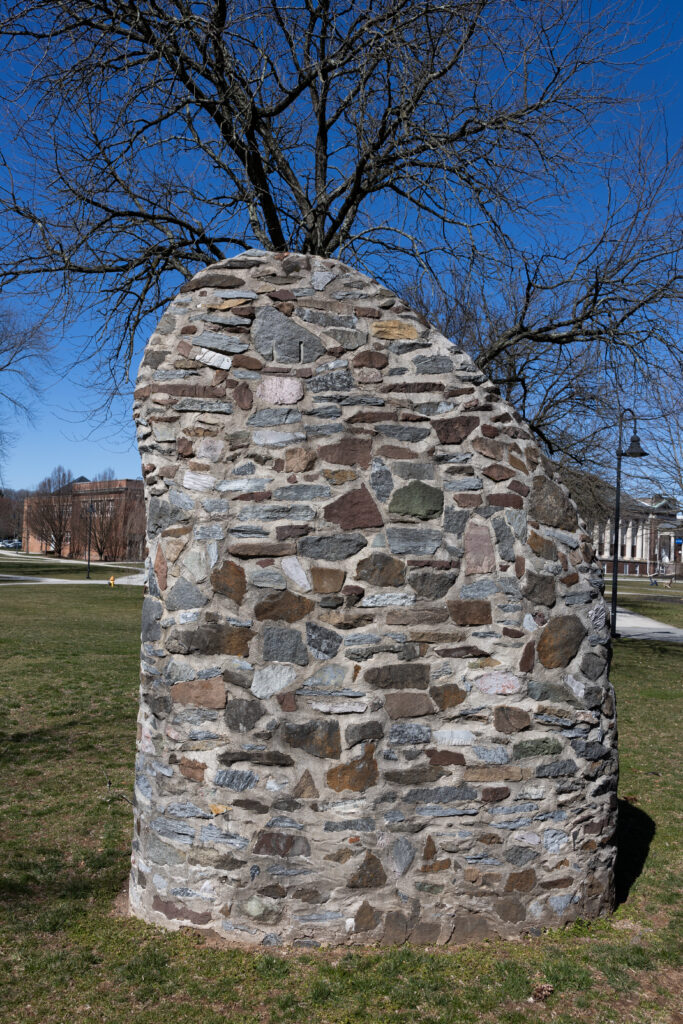What is That? The Outdoor Sculptures of Gettysburg College
By Victoria Staub, Arts & Entertainment Editor

The Sentinel (Photo Eric Lippe/The Gettysburgian)
Each day, students pass by numerous outdoor works of art and may not be aware of their origins. Some of these sculptures are straightforward depictions of people, and others are far more abstract. While some creek ominously on a windy day, others look simply like a stylized pile of rocks. Unsurprisingly, these sculptures carry unique histories, most of which have been forgotten over time. A few of these sculptures have almost no record today, but the histories of some are recounted here:
“Atlantus Rising III” by Salvatore V. DeMaio (1969)
According to the 1969 Gettysburg College Alumni Magazine, “Atlantus Rising III” is 1,000 pounds of A-32 steel located on the plaza of McCreary Hall. This sculpture was inspired by a pile of steel that the artist, Salvatore DeMaio ’69, had seen near the College. This steel pile was what remained of an observation tower from the Gettysburg National Military Park. DeMaio wished utilize this exact steel for his sculpture, but it was unfortunately not usable for this type of project. This was the first sculpture by a student to be a permanent fixture to the College’s campus.
“Eisenhower at Gettysburg” by Norman Annis (1970)
This life-size bronze statue of former President and Gettysburg legend Dwight D. Eisenhower was sculpted by former Gettysburg College art professor Norman Annis. The subject of the statue, President Eisenhower, is an older man, one that the Gettysburg community was more familiar with. According to a Cupola published paper by Jamie Kessler ’08, Annis utilized photographs and the memories of friends and associates of Ike to depict the former president as life-like as possible. In 1984, the original statue was destroyed in a storm, so Annis remade it. This new statue was “very rushed and not nearly as good as the first,” according to Annis. Currently, the statue resides outside of the Admissions Office building which formerly served as Eisenhower’s office.
“Sentinel” by Martin Puryear (1982)
Known to most students as “the rock thing near Glatfelter Hall,” “Sentinel” was commissioned as a commemoration of Gettysburg College’s Sesquicentennial. According to a recent publication by Merlyn Maldonado ’22 and Dr. Shannon Egan, “Sentinel” was awarded $22,000 in funding by the Art in Public Places Grant from the National Endowment for Arts. The College payed the additional $25,000 required to complete the project. Martin Puryear, the artist of the sculpture, utilized local fieldstones, such as stones from a local quarry and the remnants of one of the first buildings on Gettysburg’s campus, Linnaean Hall, to create an abstract piece that honors the tradition of Gettysburg in a modernist format. “Sentinel” faced quite a bit of criticism, particularly by Gettysburg students via The Gettysburgian, one of which referred to it as a “12-foot shark fin” (Michael Ripley ’84). Another student, Nicholas Micros ’82, on the other hand, helped build the sculpture. In the years following the installation of “Sentinel” on Gettysburg’s campus, Puryear became very famous in his field, even receiving the National Medal of Arts by President Obama in 2011.
Some works, such as “Anemotive Kinetic 4/97” by Robert Mangold (1997) located outside of the Science Center, serve the sole purpose of creating art from the moving wind, or at least that’s what can be inferred, given the lack of well-kept records. Others, even further lost to time, are simply stones and glass with the semblance of a name on a nearby plaque, such as “Trilogy Graces” by Glenn Zweygardt (2000-2004) located outside of Kline Theatre. Despite Gettysburg College being an institution that certainly does not allow for its own history to be forgotten, its sculptures have somehow become mysteries. Therefore, it is important for Gettysburgians to remember these works.
This article originally appeared on page 11 of the March 2023 edition of the Gettysburgian’s magazine
